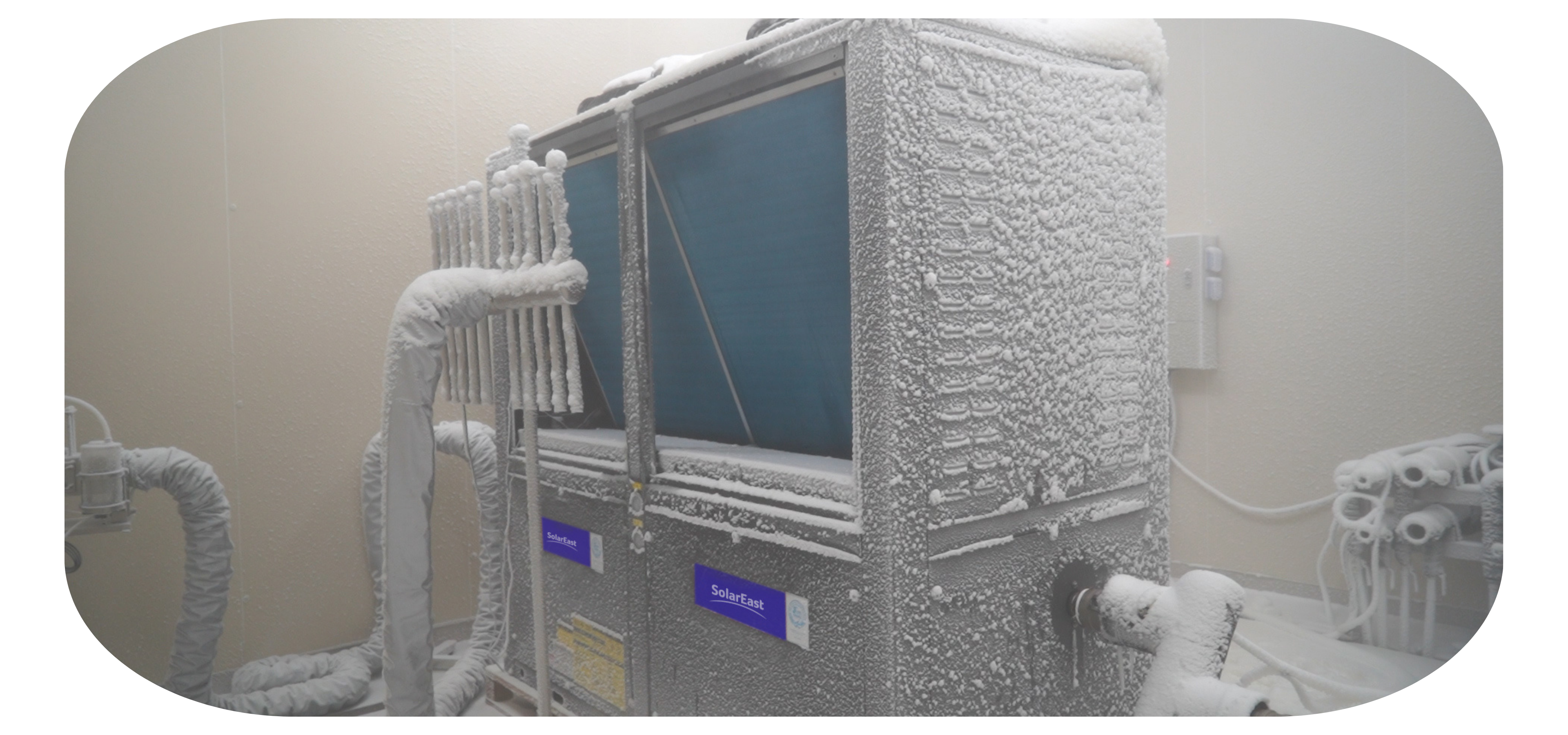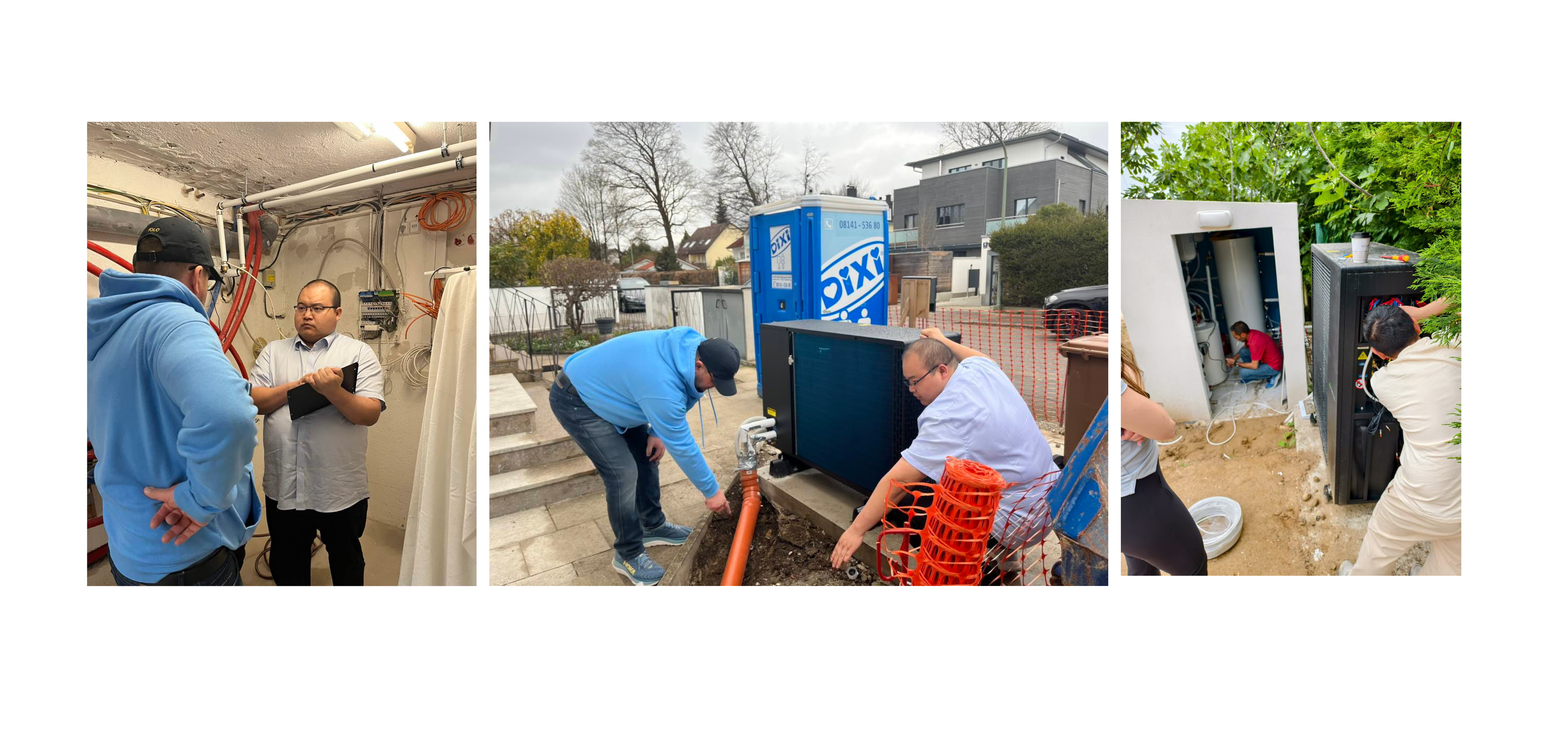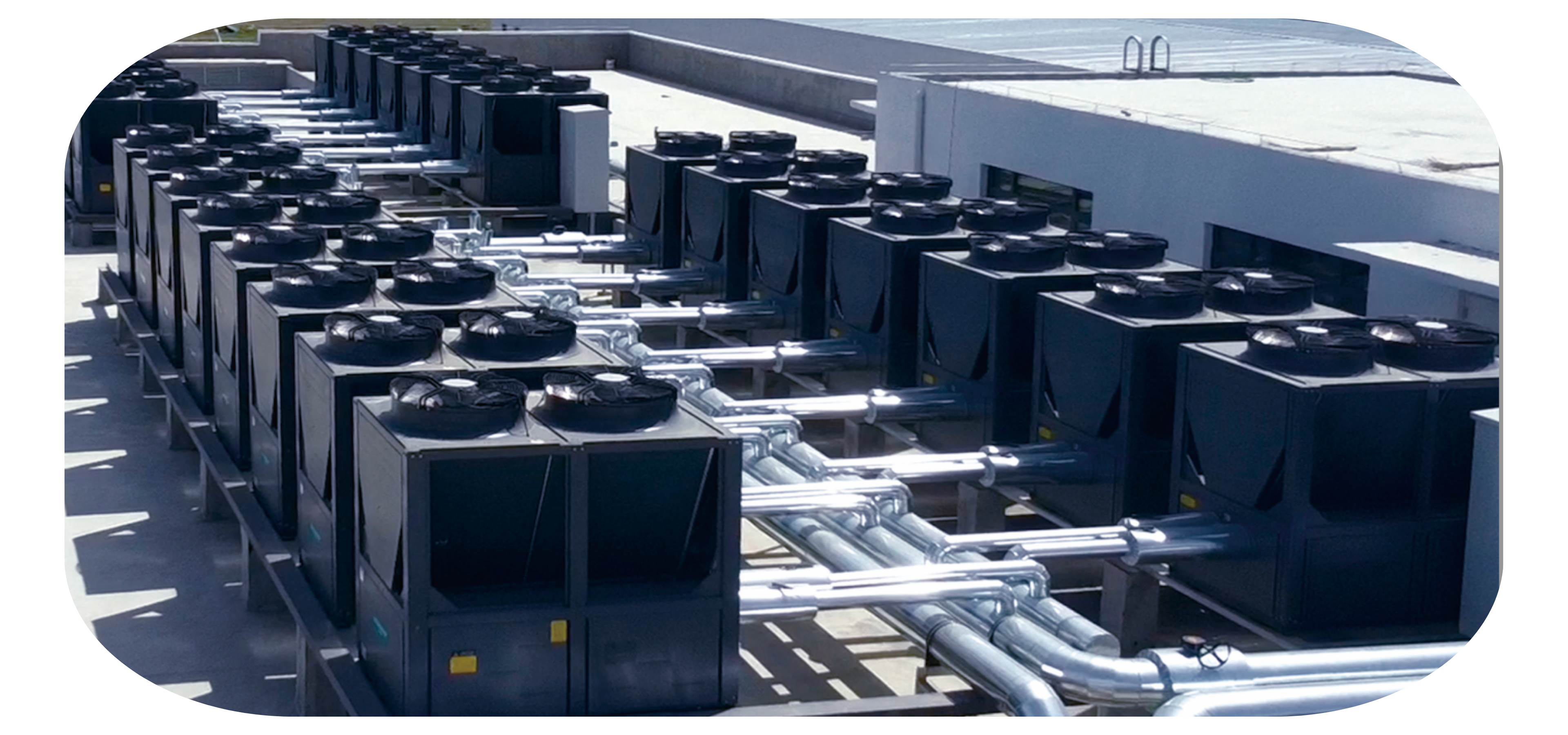Blogs
Skepticism still lingers in the heating industry. Across Europe and North America, people often claim that “air source heat pumps don’t work in freezing weather.” Today’s air source heat pumps for cold climates are designed for real European winters, combining R290 refrigerant, inverter compressors, and smart defrost systems to deliver steady performance well below freezing. They provide steady warmth, even when it’s –25°C outside. They’re efficient and can reduce energy costs during harsh winters.
Explore certified models, performance data, and subsidy options in our full guide. Powered by SolarEast, a heat pump manufacturer with 20+ years of hands-on experience in product development and manufacturing.
This guide shows how air source heat pumps for cold climates beat traditional heating systems. Whether you’re upgrading or starting a new project, you’ll learn about their efficiency, comfort, and cost benefits.
What to Look For in the Best Air Source Heat Pumps for Cold Climates
European Subsidies, ROI & Incentive Programs for Cold Climate Projects
How to Choose the Best Air Source Heat Pump for Cold Climates
Professional Installation & After-Sales Support Across Europe
FAQs: Everything You Need to Know About Cold Climate Heat Pumps
Air source heat pumps for cold climates extract heat from outdoor air, even when temperatures fall far below zero, and deliver it indoors through a hydronic heating circuit.
Modern air source heat pumps now perform better in cold climates than older boiler systems, thanks to recent advancements. They provide reliable heating during Europe’s harsh winters and reduce energy use overall.
Key innovations that make these systems effective include:
Inverter Compressors: They adjust heating output based on real-time demand. This boosts efficiency and comfort, even in freezing conditions.
Smart Defrost Cycles: Stop frost from forming on coils. This keeps things running smoothly and saves energy.
Eco-Friendly R290 Refrigerant: Provides excellent low-temperature performance. It also has a smaller environmental impact than traditional refrigerants.
Together, these features make R290 air source heat pumps for cold climates a smart and reliable choice for sustainable heating in both residential and commercial buildings.
By combining inverter technology with R290 refrigerant, these systems maintain high efficiency even during harsh Northern European winters.
Ready to find the right system?
Explore SolarEast’s certified range of air source heat pumps for cold climates, optimized for –25°C operation and compliant with European standards.
Yes — air source heat pumps for cold climates are specifically engineered to deliver steady performance well below freezing. Certified systems have been tested to operate reliably at –25°C (–13°F), with top models maintaining functionality even at –30°C (–22°F).
According to the PNNL Cold Climate Field Study (2023) and the NEEP Cold Climate Air Source Heat Pump Specification V4.0, most high-efficiency units achieve:
Minimum Operating Temperature: ≥ –25°C as standard, with advanced models verified to –30°C.
Coefficient of Performance (COP): ≥ 1.75 at –25°C, typically around 2.0 at –15°C.
Capacity Retention: At –15°C (5°F), systems retain ≥ 70% of their nominal heating capacity measured at 8.3°C (47°F).
These results prove that modern air source heat pumps for cold climates no longer need backup heating systems in most European and North American winters. Their ability to sustain high COP values even under extreme conditions makes them a dependable and energy-efficient alternative to gas or oil boilers.
Technology / Specification | Minimum Operating Temperature | Capacity Retention at –15°C | COP at –15°C (5°F) | COP at –25°C (–13°F) | Source |
NEEP Cold Climate Spec V4.0 | ≥ –25°C | ≥ 70% | ≥ 1.75 | ≥ 1.75 | |
DOE Cold Climate Challenge | –25°C to –30°C | 100% at –15°C | 2.1 – 2.4 | ≥ 1.75 | |
Median Field Performance 2023 | –25°C | 70–100% | 2 | 1.8 |

Across Europe, strict cold climate performance standards and voluntary certification programs ensure that R290 air source heat pumps for cold climates operate efficiently and safely, even under freezing winter conditions. These frameworks define testing methods at –7°C and below, verifying key parameters such as:
Heating Capacity Stability — consistent performance under low ambient temperatures.
Efficiency Ratings (COP, SCOP, ηs,h) — ensure seasonal efficiency and compliance with EU energy labeling.
System Durability & Noise Limits — confirm long-term reliability and user comfort in residential and commercial applications.
Meeting these European standards is not optional — it’s the foundation of market access, government subsidies, and consumer trust. Certified R290 air source heat pumps not only meet the EU’s energy transition goals but also qualify for national incentive programs such as BAFA (Germany), MaPrimeRénov’ (France), and Superbonus 110% (Italy).
Below is a summary of the key cold climate certification frameworks that apply to air-to-water heat pumps in Europe, with links to official testing protocols and regulatory documents.
| Certification | Scope | Key Cold Climate Requirements |
| EU Ecodesign Lot 1 (Regulation 813/2013) | Air-to-water and water-to-water heat pumps ≤400 kW | Seasonal efficiency, including SCOP, must be declared for average, colder, and warmer climates; performance at low ambient conditions (−7°C, −10°C) is mandatory with CE compliance required. |
| EU Energy Labelling (Regulation 811/2013) | Space heating heat pumps | Energy label must display colder climate (Stockholm) efficiency class (A+++ to D) and ηs,h; end users should see efficiency level at low ambient conditions. |
| HP KEYMARK Certification | Voluntary third-party certification including air-to-water HPs | Mandatory cold climate testing with COP and heating capacity measured at −7°C and −15°C; based on EN standards; includes annual retesting. |
| EHPA Quality Label | Voluntary European Heat Pump Association label | Requires testing at −7°C ambient with declared COP and capacity retention to ensure reliable performance in colder climates. |
| Eurovent Certita LCP-HP Program | Hydronic heat pumps (air-to-water, water-to-water) | Declaration of heating capacity and COP at −7°C ambient; results publicly listed in Eurovent directory. |
| National Incentive Lists (e.g., BAFA in Germany) | Heat pumps eligible for subsidies | Compliance with minimum ηs,h at −7°C or colder and must deliver ≥55°C water; stricter noise and low-temp requirements apply from 2026. |
Certified air source heat pumps for cold climates are built to meet the highest European and international performance standards. Each unit undergoes rigorous testing to verify its energy efficiency, capacity retention, and durability under sub-zero conditions.
High Seasonal Efficiency: With SCOP above 3.0 and SEER2 greater than 17, these units deliver consistent energy savings throughout the year.
CO₂ Emission Reduction: Independent analyses by the International Energy Agency (IEA) and the European Heat Pump Association (EHPA) confirm 40–75% lower emissions compared to fossil fuel boilers.
Reliable Comfort in Cold Weather: Certified R290 models maintain stable indoor temperatures and domestic hot water even during harsh European winters.
Extended Lifespan: Built for resilience, most units achieve 15–20 years of reliable operation with regular professional maintenance.
Heating System | Annual Energy Cost (€) | CO₂ Emissions | Maintenance Level | Source |
Oil Boiler | € 2,280 | High | Moderate | |
Gas Boiler | € 2,265 | High | Moderate | |
Cold Climate Heat Pump | € 1,200 | 40–75% Less | Low |
Major European countries have launched strong subsidy and incentive programs. These aim to speed up the shift to sustainable heating. They also help lower upfront costs for cold-climate heat pumps.
These initiatives match EU goals like REPowerEU and the Fit for 55package. They offer strong financial support. This help shorten ROI and payback periods for B2B buyers and installers.
Germany’s BAFA Program offers grants covering up to 40% of the purchase cost, with ceilings up to €9,000. Eligible systems typically must meet or exceed A+++ energy efficiency ratings.This program promotes pairing heat pumps with renewable energy systems for added benefits.For full program details, see the BAFA Förderprogramm Overview.
France’s MaPrimeRénov’ provides household grants up to €5,000, with higher amounts for low-income brackets. The subsidy requires installation by RGE-certified professionals to ensure quality and safety. The detailed provisions are accessible at the MaPrimeRénov’s Official Guide.
Italy’s Superbonus 110% tax credit covers 110% of investment costs. This means you can spend nothing over five years.This incentive must be combined with broader building renovations. The official program document can be found in the Superbonus Official PDF.
Country-specific subsidies are key parts of the EU’s plan to boost heat pump use. This is backed by laws like the Renewable Energy Directive and the Energy Performance of Buildings Directive.
| Country | Subsidy / Incentive | Impact on Air-to-Water Heat Pump Cost and ROI |
| Germany | BAFA subsidy | Cost €10,000 → Net cost €6,000; approx. 5 years ROI |
| Italy | Superbonus | Nearly eliminates upfront costs; ROI reduced to 2-3 years |
| France | Grants | Considerably reduces net costs; improves feasibility for mid-size projects |
Data sources: Based on EU directives and subsidy programs from BAFA Germany, Italy’s Superbonus, and French grants.
These financial incentives make investing in air source heat pumps for cold climates even more attractive, lowering upfront costs and improving ROI for long-term projects.
Choosing the best air source heat pump for cold climates depends on your building type, insulation, and desired efficiency class. Whether it’s a residential renovation or a large-scale commercial project, here are the key factors to consider:
Certifications & Standards: Always verify listings such as Energy Star Cold Climate, EU ErP, and AHRI. Certified models guarantee tested performance and eligibility for government subsidies.
Long-Term ROI: Although upfront costs are higher, modern cold-climate models can reduce annual heating expenses by 40–60%. Most users achieve a 5–8 year payback period through improved efficiency and national incentives.
Customization & Procurement: For B2B buyers, SolarEast offers OEM/ODM solutions tailored to regional climates. Bulk procurement, logistics coordination, and after-sales service agreements are available across Europe.
Professional Installation: Choose manufacturer-trained installers who can properly commission the system, ensuring optimal performance, warranty coverage, and long-term reliability.
By aligning performance certifications, ROI expectations, and professional installation, buyers can maximize comfort and minimize lifecycle costs — making air source heat pumps for cold climates one of the smartest investments in Europe’s energy transition.
When properly installed and maintained, air source heat pumps for cold climates can provide stable comfort and 30–60% energy savings compared with traditional systems.
While air source heat pumps for cold climates are among the most efficient heating options available today, hybrid systems provide an extra layer of reliability for properties facing extreme winters.
In regions where temperatures regularly fall below –25 °C, hybrid air source heat pumps for cold climates combine the advantages of renewable heating with the assurance of traditional systems. By pairing a high-efficiency R290 air source heat pump with a compact gas or oil boiler, buildings can achieve stable comfort and energy resilience even during long sub-zero periods.
Operating Principle:
The hybrid system automatically alternates between the air source heat pump and the boiler depending on outdoor temperature, operating cost, and real-time energy efficiency. When the heat pump reaches its low-temperature threshold, the backup boiler engages to maintain heating performance without interruption.
This configuration has become a trusted approach in Northern Europe, where businesses rely on air source heat pumps for cold climates to meet sustainability targets while keeping operational costs low.
Case Example – Finland Logistics Center:
A 2,500 m² logistics facility in Finland replaced its aging oil boiler with a SolarEast hybrid setup featuring R290 air source heat pumps for cold climates. The system supplied over 85% of annual heating demand, with the gas boiler only assisting during severe cold snaps. As a result, the project achieved 40% energy cost savings, over 60% CO₂ reduction, and consistent indoor temperatures throughout the harsh winter season.
The success of this hybrid deployment highlights how air source heat pumps for cold climates can remain highly efficient, even when supported by traditional systems, offering a balanced path toward energy transition and long-term ROI.

A professional setup is essential for air source heat pumps for cold climates to achieve full efficiency and longevity.
Proper installation is the key to getting the best performance out of an air source heat pump for cold climates. That’s why SolarEast partners with manufacturer-certified installers and authorized distributors across Europe and North America.
Each partner receives in-depth technical training covering system design, commissioning, diagnostics, and troubleshooting—ensuring every system operates at peak efficiency, even in sub-zero temperatures.
SolarEast also provides comprehensive after-sales support, including remote performance monitoring, maintenance tips, and upgrade guidance to extend the lifespan and reliability of your system. This strong service network guarantees long-term performance, lower operating costs, and peace of mind for both residential and commercial clients.
With SolarEast’s network of certified partners, users across Europe enjoy seamless installation and support for their air source heat pumps in cold climates.

In one of SolarEast’s recent commercial heating projects in Northern Europe, the client needed a sustainable solution capable of maintaining reliable heating during long winter periods where temperatures dropped below –20 °C. The site—a logistics and warehouse complex near the Baltic Sea—had previously relied on an oil-fired boiler that struggled with uneven indoor temperatures and high energy costs.
To meet this challenge, SolarEast deployed a set of R290 air source heat pumps for cold climates, equipped with inverter compressors, intelligent defrost control, and low-GWP refrigerant circuits optimized for sub-zero operation. During the coldest nights, the system’s automatic defrost mode engaged seamlessly, preventing icing and maintaining stable water outlet temperatures above 50 °C without interruption.
Throughout the winter season, the heat pumps consistently maintained strong heating output even during the coldest nights of –15 °C. Electricity consumption dropped by more than 30% compared with the customer’s previous fossil-fuel boiler system, while indoor temperatures remained perfectly stable.
When one outdoor unit briefly triggered a low-pressure alert caused by ice buildup, SolarEast’s remote monitoring center immediately diagnosed the issue and guided the on-site team through a quick 15-minute reset. The system was restored without any downtime — proving the reliability and smart service capability of SolarEast’s air source heat pumps for cold climates.
At the end of winter, the facility manager praised both product performance and the rapid global after-sales support, writing:
“Your R290 heat pumps kept our operations running when temperatures hit –22 °C. The remote assistance was instant—thank you for helping us through the harshest winter in years.”
This real-world case—backed by rigorous lab certifications and verified field data—demonstrates why SolarEast has become a trusted partner for cold climate air source heat pump projects across Europe and North America.It’s a clear example of how air source heat pumps for cold climates deliver both performance and dependability in real-world use.
This case highlights how SolarEast’s R290 air source heat pumps for cold climates maintained consistent operation throughout sub-zero European winters.

Do air source heat pumps for cold climates perform below −20°C?
Yes. Modern air source heat pumps for cold climates maintain stable heating capacity and achieve a Coefficient of Performance (COP) ≥ 1.75 even at −25 °C. Independent research such as the PNNL Cold Climate Field Study confirms consistent performance under sub-zero conditions. Learn more about how cold climate heat pumps work.
Why do some people say “air source heat pumps are rubbish”?
This misconception comes from early-generation models or improper installation, which caused efficiency loss in freezing weather.
Today’s SolarEast certified R290 air source heat pumps use variable-speed inverter compressors and smart defrost algorithms, ensuring reliable output even during extended cold snaps. Discover more about modern cold climate heat pump technology.
What is the typical lifespan of air-to-water heat pumps in cold climates?
With professional installation and scheduled maintenance, SolarEast systems deliver a 15–20-year lifespan. Annual inspections and timely part replacements help maintain high efficiency and extend operating life. See our installation and after-sales guide for details.
Does the defrost cycle significantly reduce efficiency?
Only slightly. The defrost cycle temporarily reduces output by about 5–10 %, but modern controls optimize timing and duration, minimizing energy waste. In practice, seasonal performance remains high—especially in R290 cold climate heat pumps with advanced refrigerant circuits. Read more about defrost operation in extreme cold.
Are subsidies or incentives available for air-to-water heat pumps?
Yes. Many EU and national programs—such as Germany’s BAFA, France’s MaPrimeRénov’, and Italy’s Superbonus 110 %—offer 30–110 % funding or tax credits for certified cold-climate heat pumps. These initiatives align with REPowerEU and the Fit for 55 plan, helping reduce upfront cost and ROI periods. Explore details in our European subsidy and incentive guide.
Are air source heat pumps for cold climates really better than gas boilers?
Yes — when designed for cold climates, R290 air source heat pumps can outperform modern gas boilers in both efficiency and lifetime cost.
Independent studies from the IEA and EHPA show that certified cold-climate heat pumps can cut CO₂ emissions by 50–70% and reduce annual energy bills by up to €1,000 compared to gas heating systems.
They also avoid fuel-price volatility and qualify for EU decarbonization incentives, making them a future-proof investment for European homeowners and installers.
Modern air source heat pumps for cold climates — especially SolarEast’s R290-certified models — redefine heating efficiency across Europe and North America.
Engineered for performance below –25°C, they combine intelligent defrost control, high COP ratings, and eco-friendly design to deliver reliable warmth year-round.
Discover SolarEast’s complete selection of air source heat pumps for cold climates, including ROI tools and subsidy options for every region.
Visit our complete heat pump buying guide for certified model catalogues, ROI tools, subsidy details, and expert OEM/ODM procurement.
